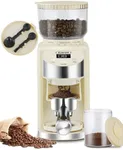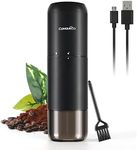Buying Guide for the Best Coffee Grinder For The Money
Choosing the right coffee grinder can significantly impact the quality of your coffee. The right grinder will help you achieve the perfect grind size for your preferred brewing method, ensuring that you get the best flavor and aroma from your coffee beans. When selecting a coffee grinder, consider the following key specifications to find the best fit for your needs.Grind Size SettingsGrind size settings refer to the range of grind sizes a coffee grinder can produce, from coarse to fine. This is important because different brewing methods require different grind sizes. For example, French press coffee needs a coarse grind, while espresso requires a very fine grind. Look for a grinder with multiple grind size settings if you enjoy experimenting with different brewing methods. If you have a specific brewing method you stick to, a grinder with fewer settings tailored to that method may suffice.
Burr vs. Blade GrindersBurr grinders use two revolving abrasive surfaces to grind coffee beans, while blade grinders use a spinning blade. Burr grinders are generally preferred because they produce a more consistent grind size, which is crucial for even extraction and better flavor. Blade grinders are usually less expensive but can result in uneven grind sizes. If you are serious about your coffee, a burr grinder is the better choice. However, if you are just starting out or have a limited budget, a blade grinder can still get the job done.
Grind ConsistencyGrind consistency refers to how uniform the coffee grounds are in size. Consistent grind size is important for even extraction during brewing, which affects the flavor and strength of your coffee. Burr grinders typically offer better grind consistency than blade grinders. If you are looking for high-quality coffee with balanced flavors, prioritize a grinder known for its grind consistency.
CapacityCapacity refers to the amount of coffee beans a grinder can hold and grind at one time. This is important if you regularly make large batches of coffee or if you prefer to grind your beans in bulk. Smaller capacity grinders are suitable for single servings or small households, while larger capacity grinders are better for families or frequent entertaining. Choose a capacity that matches your coffee consumption habits.
Material and Build QualityThe material and build quality of a coffee grinder affect its durability and performance. Grinders made from high-quality materials like stainless steel or ceramic are more durable and can provide better grind consistency. Plastic grinders may be less expensive but might not last as long. If you plan to use your grinder frequently, investing in a well-built model can save you money in the long run.
Ease of CleaningEase of cleaning is an important consideration because coffee grinders need regular maintenance to perform well and ensure the best flavor. Some grinders have removable parts that make cleaning easier, while others may require more effort to clean thoroughly. If you prefer low-maintenance appliances, look for a grinder that is easy to disassemble and clean.
Noise LevelNoise level refers to how loud the grinder is during operation. This can be an important factor if you live in a household with others or if you prefer a quieter environment. Burr grinders tend to be quieter than blade grinders. If noise is a concern for you, consider looking for a grinder that is specifically designed to operate quietly.




















